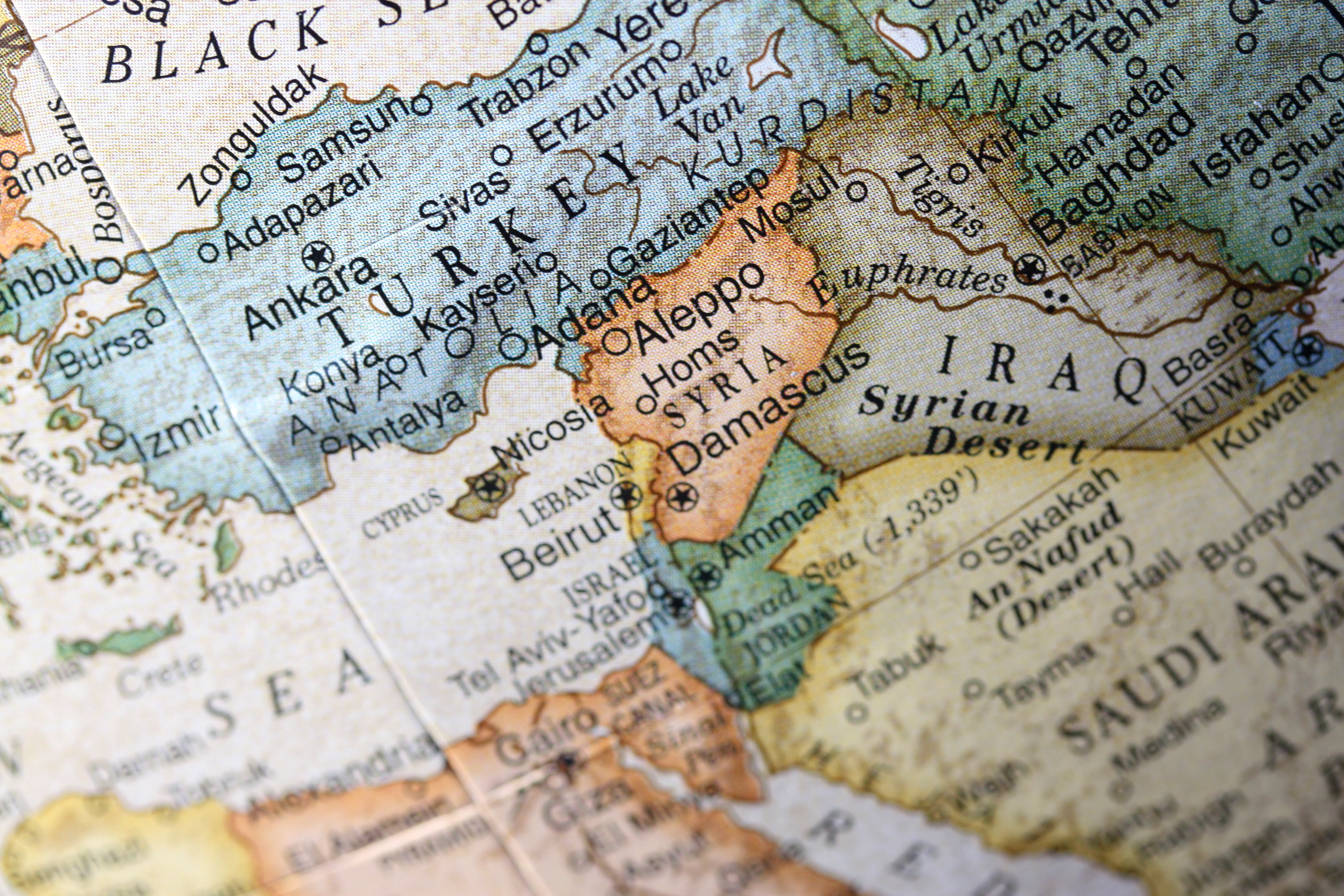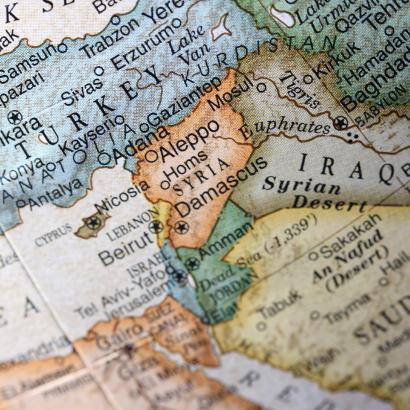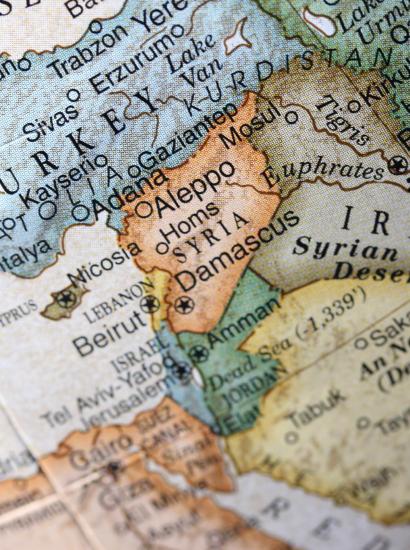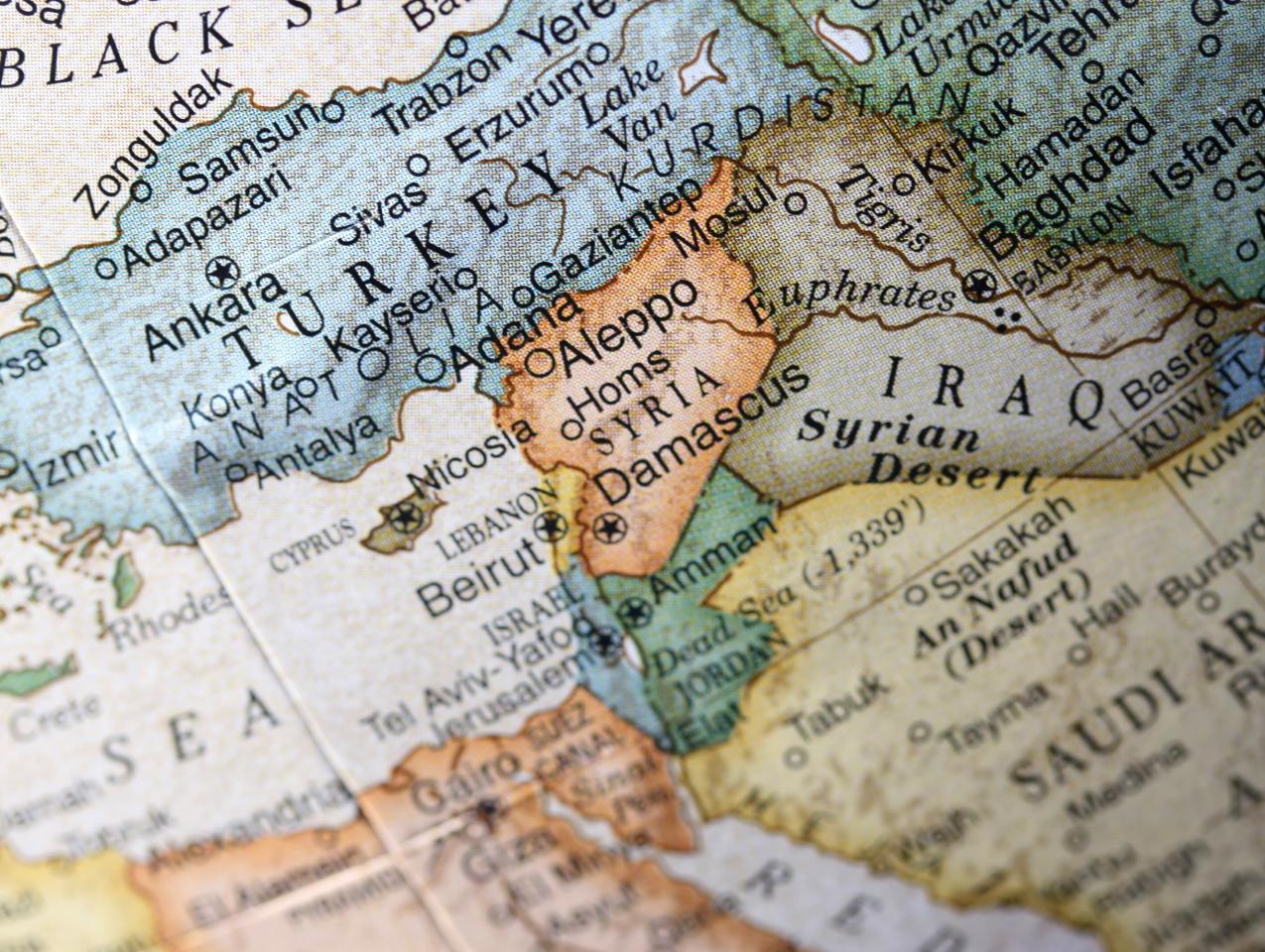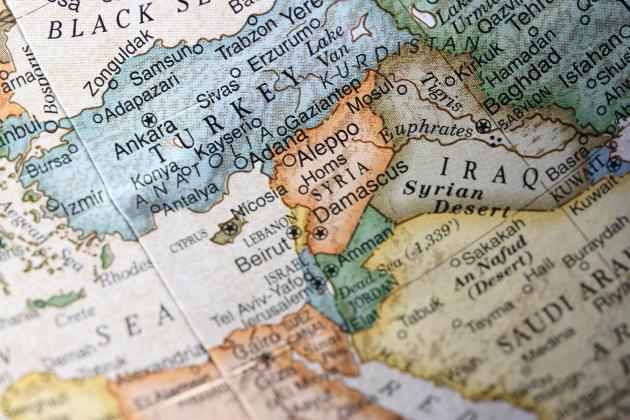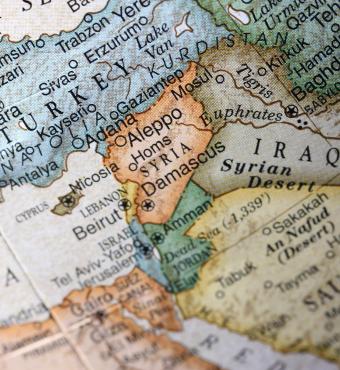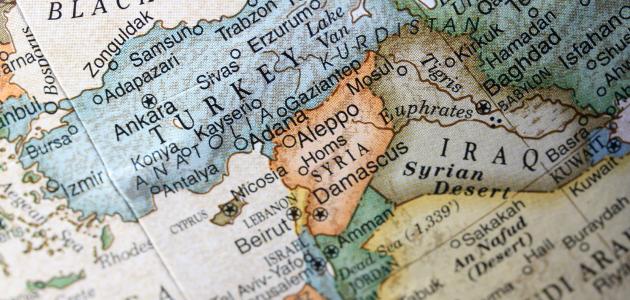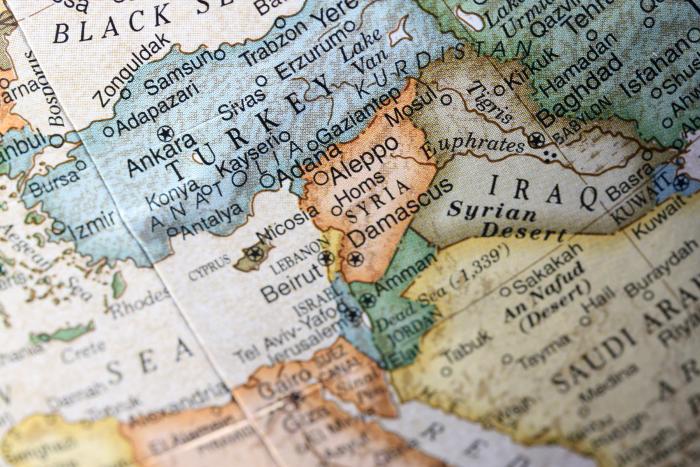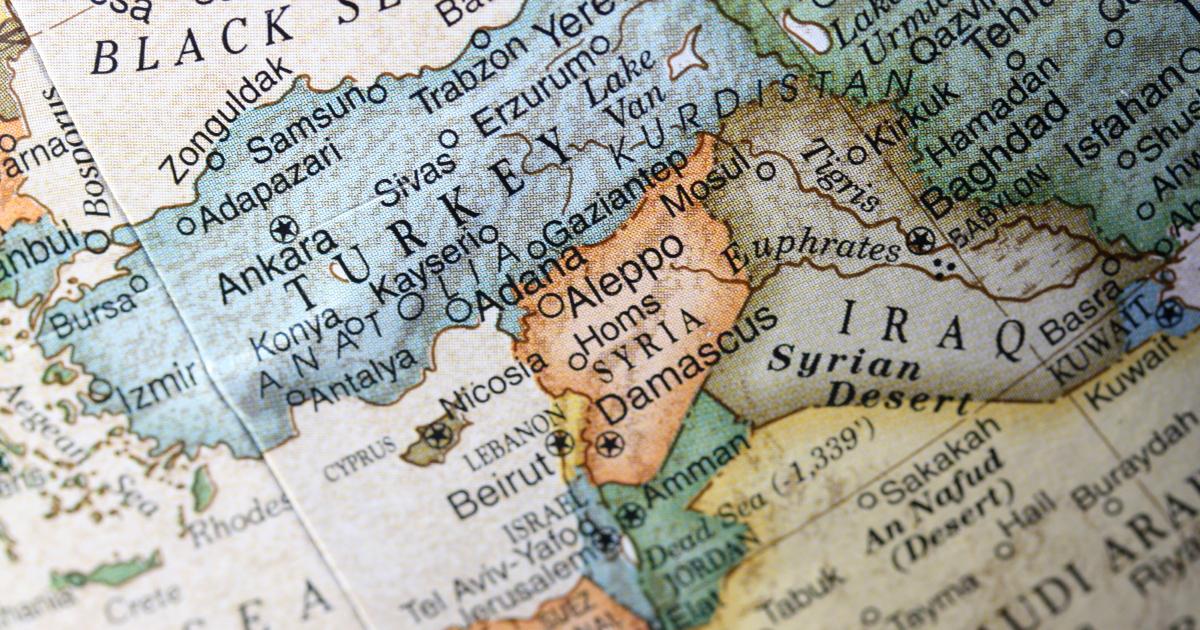- History
- Determining America's Role in the World
Despite the ongoing conflict in the Middle East, it is easy to overlook the impact of climate change. The regional conflicts are largely determined by classical geopolitics. However, it is important not to overlook the environmental factor that exacerbates domestic political conflicts and threatens the stability of nations and societies. Until now, climate has been understood to be a potential amplifier of conflicts, but it could soon become their primary cause. This consequential role of climate change is particularly salient in the specific cases of Syria and Iraq.
The impact of climate change on political geography and geopolitics has become increasingly significant. It is especially a major factor in the Middle East, where temperatures are expected to rise by twice the global average during the 21st century, reaching 4°C compared to 1.5 °C in the medium scenario (Florence Gaub and Clémentine Lienard, "Arab Climate Futures," Cahiers de Chaillot nr.170, 2021). By the end of the 21st century, precipitation could decrease by half in this region, according to Georges Zittis in his article “Climate Change and Weather Extremes in the Eastern Mediterranean and Middle East” in the Journal Reviews of Geophysics, issue 3, 2022. The water resource situation is already extremely degraded in many countries, with per capita availability having fallen below the water stress threshold (500 m3/inhabitant annually). The region has been experiencing an escalation of extreme heat waves, unforeseen sandstorms, and prolonged droughts. The environment and living conditions are deteriorating, as the ecological balance is disrupted, in part due to unsustainable economic and housing practices. Governance in many countries is weak or ineffective among the region's failed states, which limits their ability to adapt to climate change, which in turn leads to the emergence of new conflicts.
The war in Syria has been analyzed from the perspective of climate change, at least since Barack Obama claimed in 2015. In retrospect, however, it seems that his statement was more of a political argument to convince the United States to join the Paris Climate Agreements. The devastation of the Syrian war was undoubtedly more familiar to American citizens and lawmakers than were the reports of the Intergovernmental Panel on Climate Change (IPCC). The great drought of 2005–2010 in Syria destabilized Syrian agriculture, eroding food security and leading to strong internal migration. The prolonged drought did not directly trigger the civil war, but it certainly exacerbated it. That lengthy period of decreased precipitation must be considered in conjunction with other factors, such as population growth, environmental stress, and most importantly, ineffective leadership. Reduced participation created the conditions for a collapse of the rural economy in several territories, particularly the region of Deraa, the center of the uprising at the beginning of the conflict in March 2011, where the rural population density exceeded 300 inhabitants/km2. Water resources were lacking to ensure the transition to irrigated agriculture, which could be more profitable than cereal farming. Emigration to the Gulf and Lebanon had stopped because of a lack of jobs, while Damascus could no longer absorb additional rural exodus. The poor were displaced from the countryside into urban poverty belts. Poorly managed under the Baathist regime, coupled with soaring population growth, society was ripe for upheaval. After the fear barrier was shattered by the Arab Spring in Tunisia and Egypt, long-suppressed grievances erupted. While climate change did not itself spark the conflict, it certainly contributed to the situation, serving as a catalyst, hastening the revolution.
A Geopolitical Factor That Emerges
Integrating data about climate change into the study of conflicts is an emerging issue in research about the Middle East. However, this approach has pertinence far beyond this geographical area, as demonstrated by the proliferation of publications on the topic. American scientists are leading the way, especially because of their taste for interdisciplinarity, as seen in the work of Jared Diamond, the author of Collapse: How Societies Choose to Fail or Survive (2005). It is worth noting that the examination of the connection between climate change and conflicts in the United States dates back to the 1990s. The Pentagon identified it as a “strategic game changer” in 1991, leading to military academies and think tanks becoming pioneers in this field. This is why we see the emergence of early publications on the collapse of societies due to climatic factors. In 2008, Harald Welzer published Climate Wars: Why We Kill in the 21st Century, which presents a particularly bleak vision of humanity’s future. The question of whether climate change inevitably leads to conflict remains hotly debated among policymakers and scholars.
Writings on the theme of water are less alarmist, sometimes even challenging the idea of a “water war”. In 2007, American hydropolitologist Aaron Wolf demonstrated that disputes over transboundary rivers are quite rare, concentrated in a single place: the demarcation line between Syria and Israel. (Aaron Wolf, “Shared Waters: Conflict and Cooperation.” Annual Review of Environment and Resources. Vol. 32, Nov. 2007.) He is quite optimistic about the potential for resource sharing and cooperation (Aaron Wolf, The Spirit of Dialogue: Lessons from Faith Traditions in Transforming Conflict, Island Press, 2017). For the region that directly concerns us, Marwa Daoudy’s book, The Origins of the Syrian Conflict: Climate Change and Human Security (2020), offers a climate-centric analysis of the Syrian crisis. It skillfully illustrates the interconnectedness of social and political factors, as well as the vulnerability of the environment. We have witnessed these links over the last thirty years in Syria and Iraq.
Lessons From the Syrian Crisis
The effect of climate change on conflicts demands that we shift our attention to a bottom-up approach. This is where its manifestations are most tangible and where they spark immediate conflicts. Water stress exacerbates the conflict between nomads and sedentary populations, which can lead to violence. When water becomes scarce, all agricultural communities compete. In numerous urban areas, water is metered and its quality declines. In Iraq, the water crisis sparked violent riots in Basra in 2018 and protests in Erbil in the summer of 2023. These local skirmishes can escalate to a national level, threatening state stability. It is important not to overlook the underlying issue, which is the gradual decline in access to resources due to climate change, but primarily due to a lack of effective governance. This is the real problem, not the occasional outbursts of anger in response to a sudden supply cut. This is what we see in Syria, as I described in my 2024 book, Les leçons de la crise syrienne (2024). The regime of Bashar al-Assad failed to adapt the agricultural economy to water stress. Additionally, he neglected to ensure water supply in urban areas or prevent the growth of informal settlements, where living conditions deteriorated to the point of being unbearable. Of course, the galloping population growth did not make his task any easier. However, it was above all his system of power that made Syrian governance inadequate in the period prior to the outbreak of the conflict. Extreme centralization and technical incompetence, along with exclusive management of economic and social problems, made it impossible to take appropriate measures to improve the long-term situation of Syrians.
Before the conflict in Syria, environmental deterioration was primarily driven by population growth rather than climate change. The population, estimated at 3.5 million in 1947, had reached 21 million by 2011. The fertility rate had finally dropped, from 8 children per woman in the 1980s to 4 at the start of the conflict. However, the country was clearly in a situation of overpopulation, considering its resources and its development model, especially in agriculture. As a result, the expansion of irrigated land through subsidies reached a limit during the 2005–2010 drought. The state had to stop subsidizing agricultural fuel because of the increase in demand caused by the use of artesian wells due to drought. As a result, the state urgently implemented an irrigation modernization program, but funding was limited. Bureaucracy and corruption prevented its implementation in the most sensitive areas, such as the northeast (Fabrice Balanche, « The Irrigation Modernization Program in Syria », Méditerranée, 2013). Finally, the plan was not implemented in Kurdish territories. The regime wanted to see this population leave the borderlands of Turkey for the big cities of the West, where they would Arabize and give up their dream of autonomy. The protracted drought, therefore, aligned with the Baath’s Arab nationalist agenda. I had the opportunity to observe during a study mission for the French Development Agency in January 2011 that European Union aid was deliberately targeted towards Arab regions, bypassing Kurdish territories.
The Syrian uprising therefore originated primarily in the impoverished countryside, which suffers from water scarcity. The implementation of the government’s measures to limit the pumping of groundwater was met with significant resistance from the population, exacerbated by the prevalence of corruption that allowed some to continue irrigation of their fields. The poverty-stricken regions surrounding Damascus, Aleppo and Homs also served as breeding grounds for protests, as the erratic supply of water and electricity had been fostering distrust of the regime for years. That same regime offered public services and tolerated illegal housing as a way to win the support of Syrians. The environment was sacrificed to this political logic: the best agricultural land around the cities has been swallowed up by uncontrolled urban sprawl. Moreover, due to the lack of sewage infrastructure, untreated wastewater contaminated the groundwater. Housing that is built quickly with cheap materials acts as an oven in the summer and a refrigerator in the winter. It is very energy-intensive because it requires extensive air conditioning and heating.
Reconstruction is inappropriate for global warming
For the past decade, Syria has been in a state of civil war, and now reconstruction is underway in the most environmentally damaged conditions imaginable. The water shortage that existed before the war has become a structural problem due to the region’s decreased rainfall and the construction of retention dams downstream of the Euphrates by Turkey. As a result, Syrian agriculture is struggling to survive, hampered by disrupted distribution networks and insufficient government assistance. In eastern Syria, the irrigated area of the Euphrates is being restored thanks to the support of NGOs. But should we question this? Reconstruction should be a chance to modernize these outdated, very water-intensive infrastructures. However, the EU and the USA, the main donors, only want to address an emergency. The residents are rebuilding their homes with cheap, substandard materials, which are energy-intensive despite the context of shortages and rising prices. The inability of municipalities to renovate water and sewer networks is a further significant issue. They can only address leaks, leaving the water unfit for consumption at the tap due to contamination from seeping wastewater. This approach is counterproductive in the adaptation to climate change, leading to conditions for a new social upheaval.
Hasaka, a city in northeastern Syria with a population of approximately 400,000, has been predominantly reliant on tanker trucks for water since 2019. This situation results from the capture of the Anouk Spring, which supplies the city, by pro-Turkish militias. In this semi-arid environment, the water table is too salty for human consumption. Rainfall has also become insufficient to fill the retention dams built in the 1980s. These dams were built for a population that was only a tenth of its current size. For the past five years, the European Union and US-AID have been funding water transport in the Autonomous Administration of North and East Syria (AANES) without seeking a more sustainable solution. The term “reconstruction” is a contentious political issue for donors due to the sanctions on Syria, including the region controlled by the pro-Western Syrian Democratic Forces. Only German cooperation has deviated from this principle by funding the renovation of the Siwar Canal, which connects the Euphrates to Hasaka, at a cost of several tens of millions of euros. Despite this significant investment, the city remains without the necessary electricity to transport the vast quantities of water required for its supply. In addition, the Arab villages along the aqueduct route are also facing shortages and are tapping into them illegally. The Kurdish administration lacks the power to stop this practice because doing so would likely spark a rebellion. As a result, residents have no choice but to purchase water, which accounts for approximately 20% of their household expenses. Despite international assistance, a fleet of private tanker trucks supplies two-thirds of the city’s water needs from just a handful of nearby sources. However they are already overstretched and close to exhaustion. Hasaka may be the first city in the Middle East to be abandoned by its residents due to a lack of water.
The Syrian authorities are powerless. They lack the resources needed to undertake a comprehensive urban renewal project that could address current challenges. Individuals, meanwhile, live in the moment and prioritize immediate survival. The consequences of climate change seem far away to them. Their response involves installing air conditioners and generators, rather than adapting their homes in a costly but sustainable way. Therefore, solar panels are deployed only when the energy deficit becomes intolerable, not with the aim of recouping their cost in a few years. The use of insulating building materials is still utopian. The war has generalized the culture of the short-term action. If the area becomes unliveable, most of the population will think more about emigrating rather than trying to adapt to the new climatic conditions. Additionally, how could productive and efficient adaptation to the new climate be accomplished on an individual level without coordinated efforts or guidance from a proactive government?
At the start of the Syrian conflict, the government tolerated the development of illegal housing. This measure aimed to address the social crisis by providing affordable housing for the poorest. During construction, demonstrations stopped. The war accelerated this process, as millions of people became internally displaced. In many areas outside of government control, regulations disappeared. The new authorities wanted to gain legitimacy in the eyes of the population, so they tolerated illegal construction. I could see the incredible expansion of the cities of Raqqa, Qamechli and Hasaka in the form of vast informal suburbs, but also of scattered housing in the countryside on formerly protected agricultural land. This is in the region controlled by the AANES. In the Euphrates Valley, between Raqqa and the Iraqi border, farmers are building new homes in the midst of irrigated land. They encircle their properties with walls to create lots for subdivision. The Kurdish leaders of AANES cannot oppose this, as they do not want to get involved in conflicts with the Arab populations of the region. Therefore, the best arable land is disappearing, which reduces agricultural potential.
The collapse of southern Iraq
Climate change exacerbates conflicts, but its impact differs based on the local context. It does not directly cause conflict, but rather interacts with political, economic, and social factors. As a result, it is essential to conduct studies that are tailored to the specific context and subject matter at hand. Such an approach necessitates a preliminary understanding of specific conflicts, the impact of global warming, and the community’s adaptability. It is at the local level that most tensions arise, as it is daily life that is disrupted when resources become scarce, leading to violent competition. The inability of buildings to withstand heat in the absence of electricity to operate air conditioners is leading to restlessness that can escalate into riots. The deterioration of public services in densely populated urban areas, exacerbated by rural depopulation, rapid population growth, and refugee influx, has led wealthy city-dwellers to retreat into exclusive gated communities boasting cutting-edge, privately-owned facilities. This isolation provides a sense of stability, but it also widens the gap between haves and have-nots, fueling social divisions and animosity. In many countries, including Iraq, cities spread out into clusters of single-family homes or small family units. Residents no longer trust anything collective, nor do they want to rely on public services. They prefer their own generators and water sources. As a result, space-efficient collective housing becomes less attractive, while some of the best arable land disappears under uncontrolled urban expansion. However, the decrease in agricultural land, particularly irrigated land, leads to food insecurity. To maintain social peace, states have traditionally subsidized food, but they are now forced to import it at great expense, placing them in a position of geopolitical dependency.
The drying out of certain regions within a country leads to internal migrations, which can lead to tension and undermine fragile national unity. Southern Iraq used to be a lush garden, but by now, many of its irrigated areas have become barren. The submersion technique has caused salt to rise and sterilize the fields. Most importantly, the crops lack sufficient water. The conventional irrigation method is prohibitively costly. A plant needs 7 cubic meters of water to absorb 1 cubic meter; the rest evaporates in arid regions. However, when considering canal leaks and evaporation from reservoirs, the Iraqi system wastes over 90% of its input.
Additionally, the Iraqi system relies on a highly centralized framework, which led farmers to fear the government during the Baath regime. Today, no one has the power to oversee the operation of water tanks, drain the ground in the winter, or regulate usage in a way to ensure that water reaches the furthest corners of the expansive irrigation area. The most powerful steal resources from the weak. Poor leadership and a lack of concern for public interests play equal roles in the breakdown of the irrigation system. The latter exacerbates the problem, since scarcity encourages conflicts over use. In addition, the Iraqi state fails to protect agriculture against foreign competition. The arrival of Turkish and Iranian products at lower prices has led to doubts about the profitability of agriculture in the south, which in turn has caused young people to be more drawn to urban service jobs or to join the Hachd al-Chaabi militia (pro-Iranian) rather than work on the land. This leads to an intense and unstoppable exodus from the countryside.
The catastrophic situation in the countryside of southern Iraq is forcing the population to move into cities. Poverty is concentrated in the suburbs of large cities, but rural dwellers are also moving into the old, dilapidated downtowns. A significant segment of the population, rooted in tribal traditions, is expanding into peripheral areas and constructing temporary housing. They rely on political parties and tribal leaders to help them establish land ownership rights. This creates tension with the original inhabitants of the city, who oppose these developments. The deterioration of public services, various forms of pollution, and insecurity encourage the middle and upper classes to move into gated communities. In Basra, a city of five million inhabitants, at least two million of whom live in poverty belts, gated neighborhoods are multiplying. Demand for housing is high, and it is all reserved before construction begins. In the region’s medium-sized cities, including Amara and Nassiriya, the same phenomenon occurs. Due to their close ties with real estate developers, local authorities tend to prioritize the interests of property-owners over the well-being of city residents. As a result, they fail to implement policies that promote sustainable living and discourage urban sprawl.
Yet, in these contemporary communities, there remains no plan to address climate change. Buildings could be constructed with insulation materials, but developers, unsurprisingly, prioritize profit over quality. As a result, these subpar materials quickly deteriorate. Like many Iraqi cities, Basra has expanded into sprawling American-style suburbs, stretching to the horizons. These neighborhoods are designed around the use of private cars and excessive land consumption, leading to higher energy costs for urban housing and a corresponding increase in living expenses for residents.
A sudden power outage and rising fuel prices can cause the model to fail. To prevent another riot like the one in 2018, the governor of Basra and the Iraqi government decided to provide uninterrupted electricity 24 hours a day and at a very low cost. In informal communities, or for those with political influence, there is no billing. The recently constructed Chinese power plants and electricity grid are operating perfectly today. However, Iraq has a reputation for rapidly deteriorating infrastructure, especially when it is managed by a state company. The state covers the persistent and abyssal deficit of the electricity company through the oil windfall. In the short term, there may be a sudden power outage during a summer heatwave due to the exponential increase in consumption and insufficient maintenance. An electricity crisis in a desert environment where life is impossible without air conditioning during the summer will cause the rapid and massive departure of residents.
Iraq faces two major challenges: soaring temperatures and water scarcity. The nation’s resources should be directed towards addressing these two critical issues: improving housing and addressing water scarcity. Providing plentiful and almost gratis electricity and relying heavily on food imports may provide temporary relief, but it is ultimately harmful and self-defeating. It exacerbates Iraq’s reliance on oil exports and undermines its sovereignty. Iraq is wasting its wealth on consumption rather than investing in the future. The state will not be able to fulfill its rentier function for more than a few years. The rupture will be severe and will hasten the desertification of semi-arid regions where the population is currently artificially supported. A forced migration will cause people from the south and west to head for the watered mountains in the northeast, seeking a more hospitable environment. The desertification of the southern part of the country, which is mainly Shiite, has accelerated the exodus towards Baghdad, the former Sunni-dominated capital. Now, it’s the Kurds in the northeast who are afraid of seeing millions of Arab “climate refugees” flooding their territory.
Stable states are threatened by the inability of their neighbors to adapt to global warming
Discerning the political, economic, and climatic drivers of migration in the Middle East can be challenging, but a combination of factors is at play. Conflict and economic instability, such as civil war or bankruptcy (Syria, Yemen, Iraq, and Lebanon), can lead to population displacement towards more stable nations (Jordan, Turkey, and petromonarchies). We should also consider the potential link between migration and a country’s resilience to climate change. Populations cannot adapt to water stress and increasing heat on their own, except for the wealthy minorities. The lack of action by public authorities encourages international migration, even though, at first, climate change may cause only internal displacement. What is the response to this migration? Turkey has built a vast wall on its borders with Syria and Iraq to prevent migrants from entering, and it is now trying to send Syrian refugees back home. Saudi Arabia is under significant migratory pressure from Yemen, whether it is a matter of local populations or those from the Horn of Africa. The expansion of deserts has historically led to widespread displacement, and we are witnessing it again now. Access to technology could alleviate this problem, but the will to use it is crucial.
The Gulf monarchies are adapting to change by implementing widespread air conditioning and desalination of sea water. They are also investing in renewable energy sources, with the city of Masdar in the United Arab Emirates serving as a symbol of their efforts. They are also relying on technological advancements to reduce carbon emissions. Despite their efforts to maintain their population’s standard of living, the domestic consumption of hydrocarbons has now become a hindrance to Saudi Arabia’s development. As a result, Mohamed Ben Salman’s 2030 vision has been significantly revised downwards. The escalating energy demands lead to a reduction in the volume of gas and oil exports. Furthermore, the costs associated with extracting these resources rise due to the need for increased amounts of fresh water to rejuvenate the hydrocarbon films as they deplete, exacerbated by the warming climate. The cost of electricity, fuel, food, and other services provided by the former welfare state is increasing due to the decline in the trade surplus, limiting the ability of petromonarchies to maintain a growing and consumer-oriented society. This has generated a widening gap between, on the one hand, national citizens and wealthy expatriates, who are relatively protected, and, on the other, immigrant workers. Social unrest, like the protests in Basra in 2018, could potentially erupt. Finally, how can these countries maintain their stability if some of their neighbors are sinking into economic, political and “climatic” precariousness? Regional leaders should be developing greater interest in sustainable measures to adapt to climate change.
The decline in the living standards of a population can lead to discontent that has the potential to destabilize even the most prosperous states. Malicious third parties can manipulate the environment to put pressure on neighbors. I am, of course, thinking of Turkey and its strategy of retaining the waters of the Tigris and Euphrates: a powerful geopolitical lever on Syria and Iraq. But we can also imagine that Iran has little interest in seeing Iraq resolve the problem of the desiccation of the southern part of the country: Iraq must currently purchase Iranian agricultural products, and the resulting unemployed farmers form a reservoir of pro-Iranian militias that are very useful for controlling Iraq. Just like engineered famines in Ethiopia in the 1980s weakened a separatist opposition, the effects of climate change can be exacerbated today, on the scale of a state or even an entire region.
The Perpetual Conflict Trap Through Inadequate Reconstruction
Lebanon, Syria, Iraq, Yemen and the Palestinian Territories are currently experiencing significant conflicts. Some of them have a decades-long history, suggesting that they are stuck in a cycle of ongoing violence (“conflict trap”). When a country has experienced one instance of violence, it increases the likelihood of future violence. Therefore, resolving such recurring crises is not just a matter of preventing their future emergence. Rather, it is about trying to “definitely” end those that have already begun. This requires a stabilization strategy that takes into account the underlying causes, including a new parameter: climate change.
Typically, rebuilding is perceived as a post-conflict endeavor that begins after a ceasefire or peace treaty. However, empirical evidence suggests that establishing lasting stability may require multiple decades. Consequently, it necessitates a far-reaching perspective, coupled with an in-depth comprehension of the ramifications of the decisions and actions taken on the political front. Reconstruction often commences during active hostilities, particularly when they are less intense. This phase can sometimes be compared to a mutant form of conflict, where, once the weapons fall silent, it serves to displace a portion of the population, or to rebuild a new coercive apparatus. The challenges that actors face after a war can alter the balance of power between the powerful and the powerless.
It is important to recognize that the nature of modern-day conflicts has evolved significantly over the past fifty years. There are no longer distinct battle lines or clear-cut endpoints. They have become more dynamic and unpredictable. The post-conflict period is now seamlessly integrated into the previous phase of unbridled violence, but on new battlefronts, such as the economy, land use planning, or urban planning. In these circumstances, the shape of the reconstruction phase cannot be divorced from the conflict that it aims to resolve. To progress towards lasting peace, we must understand the underlying causes of the crisis. We cannot fall into a permanent spiral. Therefore, special attention should be paid to cities, which are now the epicenters of conflict in the Middle East. The concept of “urbicide” is so prevalent that it has been used to describe the destruction of numerous cities and their core areas. With increasing urbanization, conflicts and their aftermath are becoming more urbanized.
Aleppo, Mosul, Tel Afar, Raqqa, Kobane, Deir al-Zor, and many other cities in the Middle East are experiencing destruction comparable to that of Europe during the Second World War. Yet, their rebuilding fails to account for the crucial need to adapt to climate change. However, the demolition of whole districts could in fact serve as a catalyst for a complete overhaul of urban design. Currently, most rebuilding efforts happen spontaneously and without external aid or planning. Local authorities allow residents to rebuild their homes in their own unique ways using traditional methods. Even in Mosul, where the international community has provided billions of dollars in financial assistance and where the Iraqi state has significant oil revenues, it is the population that bears the burden of the reconstruction process: they end up rebuilding their homes almost exactly as they were before. The people of Raqqa and Aleppo receive no help or guidance, and their rebuilt homes are of inferior quality to those that were there before the war. The urban services are inadequate, incomplete, or faulty, leading to increased living costs that are often too much to bear. All of these cities are ticking time bombs, and the conflicts of the future, particularly those related to the failure to adapt to climate change, are brewing and keeping Syria, Lebanon, and Iraq trapped in a permanent state of conflict.
Fabrice Balanche is on the faculty of Geography at the University of Lyon. He was previously a visiting fellow at the Hoover Institution and is currently adjunct fellow at the Washington Institute for Near East Policy. His last book, Lessons from the Syrian Crisis (in French), won the 2024 Geopolitics Prize from the French Ministry of Defense.







